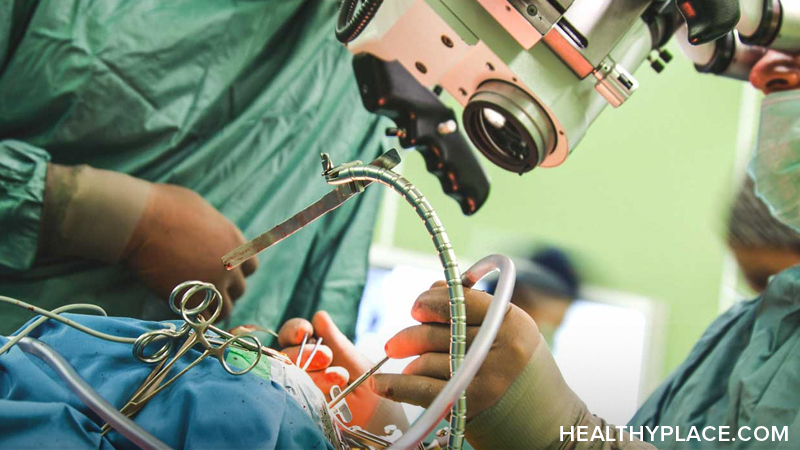How Effective is Brain Surgery for Parkinson’s Disease?

Parkinson's disease surgery – known as deep brain stimulation – is one of the possible treatment options for Parkinson's disease. Deep brain stimulation was initially approved to ease tremors in PD patients in 1997, but it was later used to treat patients in the advanced stages of Parkinson's disease. The surgery is also offered to patients in the early stages of Parkinson's disease who do not respond to medication. Learn more about the effectiveness of Parkinson's disease surgery and what it involves.
What Is Parkinson’s Disease Surgery?
Parkinson's disease surgery is a brain operation called deep brain stimulation (DBS). The surgery is also used to treat epilepsy, obsessive-compulsive disorder (OCD) and a condition called "essential tremor." DBS is widely considered one of the most significant neurological breakthroughs in recent history, posing a potential treatment for major depressive disorder, stroke recovery and addiction. Parkinson's disease brain surgery aims to interrupt problematic electrical signals from targeted areas in the brain and reduce PD symptoms.
How Does DBS Surgery Work?
Deep brain stimulation involves electrodes (also known as "leads") being inserted into the brain through a small opening in the skull. These electrodes have an extension of insulated wire that passes under the skin of the head, neck and shoulder, before connecting the lead to a neurotransmitter or ("battery pack") the size of a stopwatch. The neurotransmitter is implanted under the skin, usually near the collarbone. The role of the neurotransmitter is to deliver electrical stimulation to the parts of the brain affected by Parkinson's disease to block PD symptoms. The device will be turned on a few weeks after the surgery and will be adjusted to find the right setting for you.
Deep brain stimulation cannot cure Parkinson's disease, nor will it slow down the progression of symptoms. However, most people notice a marked reduction in symptoms after DBS, although many continue to take medication in small doses. The surgery may help you manage the effects of Parkinson's disease so that you can lead a more comfortable life with the condition.
Am I Eligible for Parkinson's Disease Surgery?
Before surgery, you will have a series of tests to make sure deep brain stimulation is the right option for you. You'll also be given a brain imaging scan to map the areas of your brain where the electrodes will be inserted.
According to The Parkinson’s Foundation, you may be eligible for DBS if you meet the following criteria:
- You've experienced PD symptoms for more than five years.
- Your symptoms interfere with your daily life and activities.
- You have ON/OFF fluctuations despite consistent medication.
- You have dyskinesias (involuntary movements of the arms, legs and head).
- Your symptoms do not get better with medication.
- You are unable to tolerate Parkinson’s disease medications due to adverse side-effects.
- Your tremor cannot be managed with medication.
- You have tried various combinations of Parkinson’s disease medications under the supervision of a neurologist who specializes in movement disorders.
In some cases, surgery may be offered to you even though you’ve responded well to Parkinson’s disease medications like carbidopa/levodopa, especially if the duration of response is deemed insufficient. Each Parkinson’s disease patient is different, so your symptoms and prognosis will be evaluated on an individual basis so that you and your doctor can decide on an appropriate treatment plan.
Parkinson’s Disease Brain Surgery: What to Expect
Parkinson’s disease brain surgery can either be done under general anesthetic or with you awake and alert with a local anesthetic to numb your skull. Either way, you shouldn't feel anything during the procedure because there are no pain receptors in the brain. The surgery is performed in two parts: one for the insertion of electrodes into your brain, and one for the placement of the neurotransmitter in your chest.
After surgery, your device will be turned on at the doctor’s office and you will be given a remote control to take home with you. From then onwards, your doctor will work with you to help you manage your symptoms. You may also decide to turn the device off at certain times. It could take a few months to find the right setting for you.
What Are the Risks?
As with any surgery, there are risks associated with deep brain stimulation. If you have DBS, you have about a 3% risk of seizure, infection and confusion. Parkinson's disease deep brain stimulation also carries a small chance of stroke. Once the neurotransmitter device is turned on, you may experience side-effects such as numbness, muscle tightness, tingling sensations balance problems or mood changes; these can be managed with help from your doctor.
Your doctor will work with you to assess your Parkinson’s disease and surgery eligibility and discuss the advantages and disadvantages of this treatment route. If you have any questions, do not hesitate to run them past your treatment provider or call the National Parkinson’s Foundation helpline on 1-800-4PD-INFO (473-4636) for more information.
APA Reference
Smith, E.
(2022, January 28). How Effective is Brain Surgery for Parkinson’s Disease?, HealthyPlace. Retrieved
on 2024, November 20 from https://www.healthyplace.com/parkinsons-disease/treatment/how-effective-is-brain-surgery-for-parkinsons-disease



